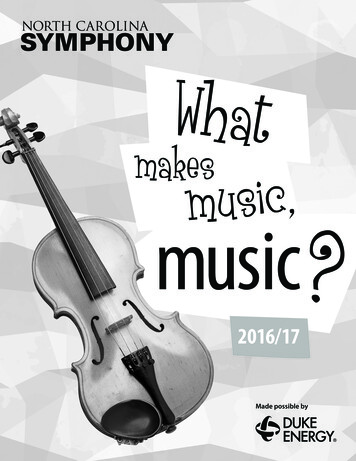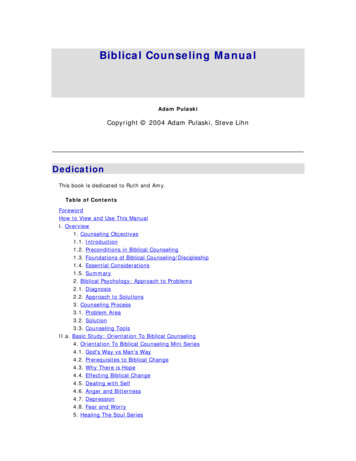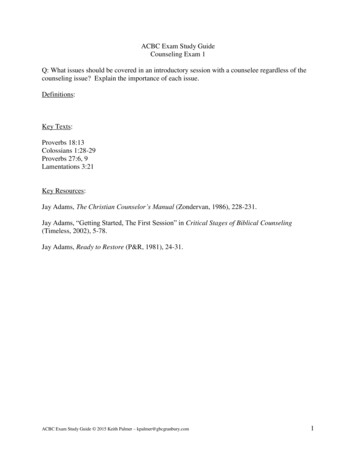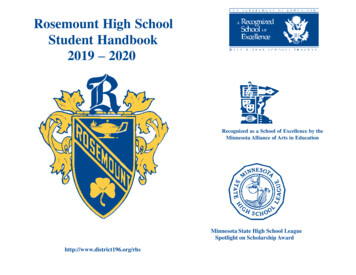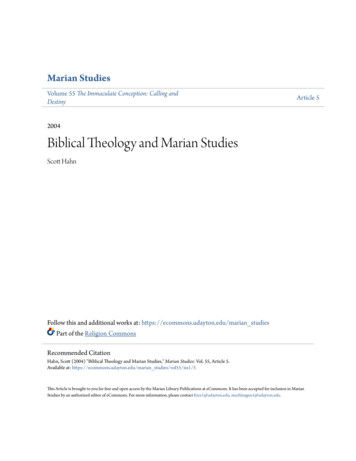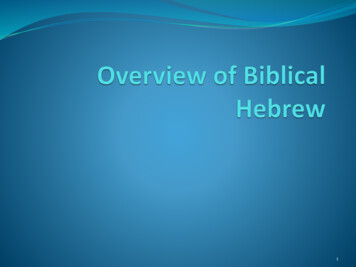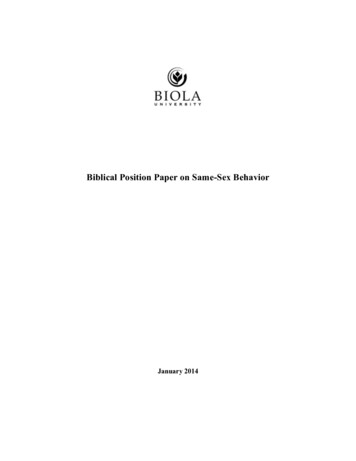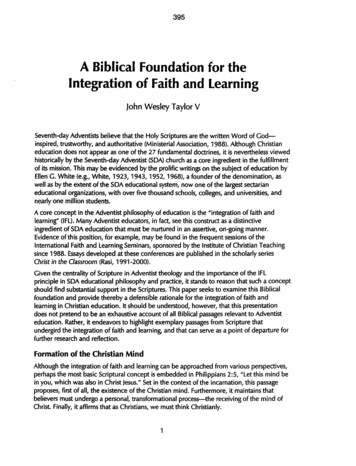
Transcription
395A Biblical Foundation for theIntegration of Faith and LearningJohn Wesley Taylor VSeventh-day Adventists believe that the Holy Scriptures are the written Word of Godinspired, trustworthy, and authoritative (Ministerial Association, 1988). Although Christianeducation does not appear as one of the 2 7 fundamental doctrines, it is nevertheless viewedhistorically by the Seventh-day Adventist (SDA) church as a core ingredient in the fulfillmentof its mission. This may be evidenced by the prolific writings on the subject of education byEllen G. White (e.g., White, 1923, 1943, 1952, 1968), a founder of the denomination, aswell as by the extent of the SDA educational system, now one of the largest sectarianeducational organizations, with over five thousand schools, colleges, and universities, andnearly one million students.A core concept in the Adventist philosophy of education is the "integration of faith andlearning" (IFL). Many Adventist educators, in fact, see this construct as a distinctiveingredient of SDA education that must be nurtured in an assertive, on-going manner.Evidence of this position, for example, may be found in the frequent sessions of theInternational Faith and learning Seminars, sponsored by the Institute of Christian Teachingsince 1988. Essays developed at these conferences are published in the scholarly seriesChrist in the Classroom (Rasi, 1991-2000).Given the centrality of Scripture in Adventist theology and the importance of the IFLprinciple in SDA educational philosophy and practice, it stands to reason that such a conceptshould find substantial support in the Scriptures. This paper seeks to examine this Biblicalfoundation and provide thereby a defensible rationale for the integration of faith andlearning in Christian education. It should be understood, however, that this presentationdoes not pretend to be an exhaustive account of all Biblical passages relevant to Adventisteducation. Rather, it endeavors to highlight exemplary passages from Scripture thatundergird the integration of faith and learning, and that can serve as a point of departure forfurther research and reflection.Formation of the Christian MindAlthough the integration of faith and learning can be approached from various perspectives,perhaps the most basic Scriptural concept is embedded in Philippians 2:5, let this mind bein you, which was also in Christ Jesus." Set in the context of the incarnation, this passageproposes, first of all, the existence of the Christian mind. Furthermore, it maintains thatbelievers must undergo a personal, transformational process-the receiving of the mind ofChrist. Finally, it affirms that as Christians, we must think Christianly.111
396According to 1 Corinthians 2:14-16, there are two types of individuals: (1) the natural manor woman, who has no discernment of spiritual things, and (2) the spiritual person, whodiscerns all things from a spiritual point of reference, having received the mind of Christ. Thepassage indicates that the difference lies in the mind. Romans 8:6, 7 corroborates this view,"To be carnally minded is death; but to be spiritually minded is life and peace. Because the.carnal mind is enmity against God." There are thus two kinds of minds, the carnal mind andthe spiritual mind. The carnal orientation runs counter to God and His truth. It is a secularmind-a temporal, world-oriented, fragmented perspective (see Figure 1). By contrast, thespiritual mind is a Christ-like mind, in harmony with God's plan for life and the universe atlarge. It thus incorporates an eternal, supernatural, holistic perspective.Figure 1. The Two Minds (Rom. 8:6-7)Uving for the presentjust do itt Enjoy it while it lasts!Let us eat, drink, and be merry, fortomorrow we die (1 Cor. 15 :32).Assuming that this world is all there isDedsions and behaviorsare limited to the criteriaof Rtflis worlda Cor.Segmenting existenceOne's life is reduced to a fragmentedcollection of ideas and activities.Often a spirituaVsecular dichotomy.An eternal orientationEvery decision, every actionin this life haseternaluences.A supernaturalSeeing life from God's point of view.Making value judgmentsbased on God's character.A wholistic worldviewNot dichotomized norcompartmentalized.Rather, Christianity embraces all of life.Often, individuals seem to assume that the mind is analogous to a suit of clothes--somethingone puts on and off at will, depending on the season (perhaps the basis for the oft-heardexpression "I just changed my mind"). The Christian mind, however, requires a certainstability, a faith commitment. james states, "If any of you lacks wisdom, let him ask of God .and it will be given to him. But let him ask in faith, with no doubting ["nothing wavering"KJV], for he who doubts is like a wave of the sea driven and tossed by the wind. For let notthat man suppose that he will receive anything from the Lord; he is a double-minded man,unstable in all his ways" (1 :S-8).Note that there are three conditions to receiving wisdom: commitment, faith, and petition.By contrast, a "double-minded" person, oscillating between a secular and a spiritualperspective, is caught in a mental dichotomy and cannot not receive anything from Godmuch less the mind of Christ and its consequent wisdom. Whenever there is a living spiritualcommitment to God, however, evidenced in singleness of mind and purpose, there is bornthe prayer of faith, which results in wisdom, the gift of God.This faith commitment, this singleness of mind lies at the heart of the Christian experience.Christ Himself declared, "Every kingdom divided against itself will be ruined, and every cityor household divided against itself will not stand . He who is not with me is against me,2
397and he who does not gather with me scatters" (Matt. 12:25, 30 NIV). In essence, theChristian mind is either completely Christian, or it is not Christian at all.Comprehensiveness of Life and LearningSingleness of mind brings about a comprehensive, holistic, Christ-centered view of life andlearning. This is in direct contradiction to a dualistic perspective.Early on, the Gnostics divided man into matter (evil) and mind (good). Based on this Greekdualism, we also have tended to fall into dichotomous forms of thinking-such as soul/body,piety/action, world/church, mercy/justice, liberty/responsibility, love/authority, theory/practice, student/subject, and faith/learning. The result is a fragmented thinking, and acompartmentalized, polarized life.Perhaps the most dangerous dualism for the Christian, however, is to think that some aspectsof life are spiritual and others, secular. Sometimes, in fact, we begin to think secularly evenabout sacred things--such as baptisms, offerings, and Christian education. The Word,however, emphasizes that we must ''Put on the new man, who is renewed in knowledgeaccording to the image of Him who created him, where there is neither Greek nor jew,circumcised nor uncircumcised . . , slave nor free, but Christ is all and in all" (Col. 3:10, 11).This pervasiveness of Christ in every aspect of life is echoed throughout the Scriptures."Therefore, whether you eat or drink, or whatever you do, do all to the glory f God" (1 Cor.10:31 ). "Whatever you do in word or deed, do all in the name of the Lord jesus" (Col.3:17). What are the implications for education? First of all, it would seem that all aspects oflife-even such common activities as eating and drinking, teaching and learning-mustglorify God. Teaching, furthermore, is a matter of both words and deeds. To teach "in thename of jesus" means to act as His official representative-to say what He would say, to actas He would act.Paul highlights this imperative: "We demolish arguments and every pretension that sets itselfup against the knowledge of God, and we take captive every thought to make it obedient toChrist" (2 Cor. 10:5 NIV). Curricular programs are made up of courses, courses arecomprised of topics, topics of concepts, concepts of ideas, and ideas of thoughts. Thus, ifevery thought is captive to Christ, it implies that every class period, every subject area, andevery educational experience must be consequently anchored in jesus Christ.How do these conditions come about? Romans 12:2 admonishes, ''Do not be conformed tothis world, but be transformed by the renewing of your mind." In the very beginning,mankind was formed "in the image of God" (Gen. 1 :26, 27). Tragically however, man choseto be conformed to this world, to take the distorted shape of sin, to be pressed into the moldof this secular age. As a result, man was deformed-he began to lose the original form, the ·likeness to his Creator. The good news is that, by the grace of God, human beings can bereformed by a renewing of the mind-a spiritual rebirth. This reformation brings about achange-a metamorphosis, a radical transformation in which the image of God is restored inmen and women, who form the family of God (see Figure 2).3
398Figure 2. Processes of Change (Rom. 12:2)Formed in the Image of GodConformed -- DeformedIReformedTransformedForm the Family of GodAs the Apostle Paul aptly summarized, "Now we have received, not the spirit of the world [asecular worldview], but the Spirit who is from God [a Christian worldview], that we mightknow the things that have been freely given to us by God" (1 Cor. 2:12).Integrating Faith, Learning, and LifeAccording to Scripture, faith, learning, and life are closely intertwined. Paul states, "Faithcomes by hearing, and hearing by the word of God" (Rom. 10:17). And the apostle Jamesdeclares, "Faith, without works, is dead" Oames 2:17; also 1:22-25). It seems evident thatfaith and learning have been intimately joined through the power of the Word (see Figure 3).It is not sufficient, however, to merely know, nor even to believe. Rather, there must be a liferesponse. "In your lives, you must think and act like Christ jesus" (Phil. 2:5 NICB). Christiansmust thus translate faith into practice and grapple with the implications of learning for theirlives. Let us consider briefly each of these components from a Biblical perspective.Figure 3. Unking Faith, Learning, and Ufe (Rom. 10:17; }ms. 2:17)Faith. Christ asked his disciples, "When the Son of Man comes, will He really find faith onthe earth?" (luke 18:8). Faith is not blind devotion or lame belief. Rather, faith is areasonable commitment, based upon substantial evidence (Heb. 11 :1 ). Christianity, then, isa matter of significant acts and facts, not simply vague theories or interesting speculations.Furthermore, faith does not exist in isolation, in a vacuum. It must have an object. One musthave faith in something or someone. What type of faith then is needed? (see Figure 4) Theoverarching tier in the faith paradigm is faith in God, based on an understanding of God that4
399is both theological (knowing about God) and relational (knowing God personally). This faithis complemented by confidence in God's revelation of His truth, His character, and His plan.The third type of faith-sometimes the most difficult to attain-is faith in persons, in the ·potential of others and of self, by the grace of God.Learning. To learn is to change. It is a transformation of heart, mind, and being. It representsa change in knowledge, skills, attitudes, and/or values. Christ invited His listeners, "Comeunto Me. and learn from Me . " (Matt. 11 :28, 29). What type of learning is needed? First ofall, there must be a change in the mind-learning to think Christianly. This is followed by achange of life-learning to live by faith.Life. Life is more than mere existence. Christ declared, "I am come that they might have life,and that they might have it more abundantly" Oohn 10:1 0). life then goes beyond simplycoping and surviving; it goes beyond self. In its fullest sense, life is God-centered, for God isSource of life. He is the Sustainer of life. He is the ultimate Focus of life. "And this is eternallife, that they may know You, the only trueFigure 4. Integrating Faith, Learning, and LifeGod, and jesus Christ, whom You have sent"Oohn 17:3). What type of life is needed? (1)FaithEternal life, a gift of God through Christ, (2) aWIn God-both theological and relationalproductive life, transforming knowledge into In divine revelation-of His truth, Hispractice, and (3) a meaningful life, filled withcharacter, and His planlove toward God and man. In persons-the potential of others andIntegration. Referring to the marriage union,Christ stated, "They are no longer two, butone. Therefore what God has joined together,let man not separate" (Matt. 19:6 NIV). Thiscovenant is analogous to the concept ofintegration. The integration of faith, learning,and life is more than a mingling or chanceencounter. Rather, it is a dynamic union, abringing together of fragments into a livingwhole.of self, by the grace of GodLearningJSr To think Christianly-a change in mindW To live by faith-a change of lifeLifeW Eternal-a gift of God through ChristW Productive-transforming knowledgeinto practiceW Meaningful-filled with love toward Godand manIntegrationW Faith and learning fuse within the contextWhat then is the integration of faith, learning,of a Christian life.and life? It is when Christian beliefs and valuesprovide the focus and core of the academicendeavor; which, in turn, seeks to relate Christianity to the entirety of human existence andculture.An Integrated Educational ProgramOne of the most significant passages in Scripture to delineate the features of a Christiancurriculum is found in the sixth chapter of Deuteronomy, verses 4-9. This passage begins bydeclaring, "Hear, 0 Israel: The Lord our God, the Lord is one!" This verse, considered bymany jews to be one of the most sacred in the Torah, identifies God as the focus of the5
400educational program (see Figure 5). This emphasis is reiterated throughout Scripture. "Forthe lord gives wisdom; from His mouth come knowledge and understanding" (Proverbs2:6). "My purpose is that they may. have the full riches of complete understanding, inorder that they may know the mystery of God, namely, Christ, in whom are hidden all thetreasures of wisdom and knowledge" (Col. 2:2-3 NIV). God, in essence, is the corecurriculum.Figure 5. The Integrated Currirulum (Deut. 6:4-9)The next verse (Deut 6:5) describes thedynamic and scope of the curriculum. "Youshall love the lord your God with all your heart,with all your soul, and with all your might" InChristian education, love is to be the primemotivational component Truth, in fact, mustalways be spoken in a context of love (Eph.4:15). Further, the scope of the educationalprogram must be comprehensive and holistic. Focus: God (4)Dynamic: Love (Sa)Scope: Comprehensive and holistic (Sb)Source: The Word-Written, Illustrated,and Living (6a) Instrument: Committed teacher (6b) Process: Diligent and excellent,receptive and active (7a) Setting: Prime moments for learning,linking theory and practice (7b) Dimensions: Physical, intellectual,spiritual, and social development (8,9)The source and instrument of the curriculumare next identified. "These words which Icommand you today shall be in your heart" (6).The words of God include His written Word, the Holy Scriptures (Rev. 1 :1, 2); the illustratedWord, as seen in God's created works (Ps. 19:1); and the living Wor.d, jesus Christ Oohn1 :14). These divine Words constitute the great unifying factor in Christian education, thefoundation of its curriculum. They bring about a transformation in learning and life. As Paulwrote to Timothy, "All scripture is given by inspiration of God, and is profitable for doctrine,for reproof, for correction, for instruction in righteousness, that the man of God may becomplete, thoroughly equipped for every good work" (2 Tim. 3:16, 17). Note, however1 thatDeuteronomy stipulates a condition: the Words must first be internalized in the instrument;in the teacher's life. One simply cannot share what one does not have.Deuteronomy 6:7 specifies the curricular process and setting. "You shall teach themdiligently to your children, and shall talk of them when you sit in your house, when you walkby the way, when you lie down, and when you rise up." To teach diligently suggests thateffort, perseverance, and excellence are required. Such instruction incorporates bothreceptivity and activity ("sitting" and "walking"). It takes place both "in the house" (theclassroom) and "by the way" (real life experiences), thus linking together theory and practice.Furthermore, it identifies certain prime moments for learning-"when you rise up" and"when you lie down" (the start and end of the day). Given that the most importantdimension of life is one's relationship with God, this would seem to suggest setting asideprime segments of the day (including the school day) for worship and devotionalexperiences.Finally, in verses 8 and 9, the passage addresses the curricular dimensions of the educationalprogram. "You shall bind them as a sign on your hand, and they shall be as frontlets betweenyour eyes. You shall write them on the doorposts of your house and on your gates." Notethat four dimensions are specified. God's words are to be on the hand, guiding one's actions6
401and physical development They are to be before the eyes, directing one's thoughts andintellectual growth.What about the doorposts and the gates? It's important to recall these words were spoken tothe Israelites who had recently left Egypt for the Promised land. On that last night, theysprinkled the blood of the lamb on their doorposts in evidence of their faith commitment. InBible times, as in many places today, the gates of one's courtyard were considered to be theavenue of contact with the larger world. Messages, in fact, would often be posted on thegates to announce important events-a form of communication, of witness. The "doorposts"and ligates" thus suggest that God's words should guide the student's spiritual as well associal development.These four dimensions of the Christian curriculum seem to be of particular significance. luke2:52, for example, states that Jesus Christ developed in four areas-" in wisdom and stature,and in favor with God and man" (see Figure 6). But perhaps even more important is theunderstanding that God's Word is to serve as the foundation for each dimension. In essence,every aspect in the Christian educational program must be Christ-centered, Bible-based,student-related, and socially-applied.Figure 6. Dimensions of the Christian curriculum (Duet. 6:8, 9; Luke 2:52)uponthe handjesusChristFavorwith th manHumanRole of the InstrumentalitiesThe Scriptures identify the parak/etos (the Comforter), parents, priests, and pastor/teachers asthe principal instruments in the teaching/learning process. Of these, the Holy Spirit isparamount. "But the Counselor, the Holy Spirit, whom the Father will send in my name, willteach you all things a d will remind you of everything I have said to you" Oohn 14:26 NIV).Although the Holy Spirit can speak directly to the mind of the student, it also mediatesthrough the other divinely appointed instrumentalities. Paul, for example, stated, "Thesethings we also speak, not in words which man's wisdom teaches but which the Holy Spiritteaches, comparing spiritual things with spiritual" (1 Cor. 2:12-13). He also noted that thechanges brought about in students' lives were the result of the Spirit of God operatingthrough human instrumentalities. "You are manifestly an epistle of Christ," he wrote,"ministered by us, written not with ink but by the Spirit of the living God, not on tablets ofstone but on tablets of flesh, that is, of the heart" (2 Cor. 3:2-3).7
402In the Biblical model, the first educational agency is the home. Consequently, parents are toassume a significant, ongoing role in the education of their children. Psalm 78:1-7, forexample, highlights the intergenerational teaching relationships. ''We will tell the nextgeneration the praiseworthy deeds of the LORD, his power, and the wonders he has done.He decreed statutes for Jacob and established the law in Israel, which he commanded ourforefathers to teach their children, so the next generation would know them, even thechildren yet to be born, and they in turn would tell their children. Then they would put theirtrust in God" (NIV). This sentiment is echoed in other Scriptural passages, such as Ps. 34:11,lsa. 38:19, and Eph. 6:4. This latter passage, for example, enjoins fathers to bring up theirchildren "in the nurture and admonition of the lord" (KJV).In Old Testament times, the role of parents was supplemented by that of the priests. "for thelips of a priest ought to preserve knowledge, and from his mouth men should seekinstruction-because he is the messenger of the LORD Almighty" (Mal. 2:7 NIV). In the NewTestament period, the church functioned as the extended family of God and every leader ofthe faith community was considered a teacher (Giles, 1989). These leaders includedapostles, prophets, bishops, elders, and deacons. Elders, for example, were enjoined toteach by example and to see themselves as "shepherds of God's flock that is under your care,serving as overseers-not because you must, but because you are willing, as God wants youto be; not greedy for money, but eager to serve; not lording it over those entrusted to you,but being examples to the flock" (1 Peter 5:1-3 NIV).There were, however, individuals who were especially commissioned for the work ofteaching. "And the things that you have heard from me among many witnesses, committhese to faithful men who will be able to teach others also" (2 Tim. 2:2). Paul furtherobserves that God "gave some to be apostles, some to be prophets, some to be evangelists,and some to be pastors and teachers, to prepare God's people for works of service, so thatthe body of Christ may be built up until we all reach unity in the faith and in the knowledgeof the Son of God and become mature, attaining to the whole measure of the fullness ofChrist" (Eph. 4:11-13 NIV). It is important to note that based on the Greek text, the passagerefers to four groups of people (Hocking, 1978, p. 21), with the function of pastor andteacher considered to be one and the same gift. Thus pastors are to see their role as teachersof their congregations, while teachers are to understand their calling as shepherds (i.e.,pastors) of their students. Notice that the ministry of these pastor/teachers results in adevelopment of faith, knowledge, and service; in essence, an integration of faith, learning,and life.In the Biblical paradigm, however, teachers are but representatives of the Master Teacher."We are ambassadors for Christ, as though God were pleading through us" (2 Cor. 5:20). Anambassador, of course, receives authority, as well as the responsibility to present anaccurate, appealing picture of whom he represents. "If anyone speaks, he should do it asone speaking the very words of God. If anyone serves, he should do it with the strength Godprovides, so that in all things God may be praised through jesus Christ" (1 Peter 4:11 NIV;also 2 Tim. 2:15). In the ultimate sense, then, God is the teacher in Biblical education. Asthe prophet Isaiah pointed out, "And all thy children shall be taught of the lord; and great8
403shall be the peace of thy children" (Isaiah 54:13 KJV). The original text denotes somethingmore than just learning about God. Rather, students are to be taught by God, through Hishuman instrumentalities.Perspectives on Content and MethodFrom an integrational perspective, divine truth and values form the bedrock of theeducational experience. An understanding of God's truth is mediated through His WordOohn 17:17), under the guidance of the Holy Spirit Oohn 16:13). It is also illustrated tangiblythrough the life and teachings of jesus Christ Oohn 14:6). Given that all truth in any subjectarea is ultimately God's truth (Holmes, 1977), students must be led to relate the truthfulnessof every topic they study to the ultimate Source of Truth.The integration of faith and learning also emphasizes the importance of moral values in theformation of the character. 11 He has showed you, 0 man, what is good; and what does theLord require of you, but to do justly, and to love mercy, and to walk humbly with yourGod?" (Micah 6:8). Teachers, for example, are to help students understand 11the difference'between the holy and the common and show them how to distinguish between the uncleanand the clean" (Ezekiel 44:23 NIV). This is best accomplished through a process of valuesformation and maturation that involves analysis, reflection, and action. The apostle Paulportrays that vast value-laden agenda for Christian education: 11 Finally, brothers, whatever istrue, whatever is noble [honest KJV], whatever is right, whatever is pure, whatever is lovely,whatever is admirable, if anything is excellent or praiseworthy-think about such things.Whatever you have learned or received or heard from me, or seen in me-put it intopractice. And the God of peace will be with you" (Phil. 4:8-9 NIV).This perspective regarding God-derived truth and values-oriented learning permeates everysubject area. In the sciences, for example, students must be encouraged to integrate thewords and works of God. The basis for this integration is found in the fact that the LivingWord formed nature Oohn 1 :1-4), that God set aside a day of rest in which to especiallyview nature in a spiritual context (Ex. 20:8-11 ), that Christ derived spiritual truth from naturalsettings (e.g., Matt. 6:28-30; Mark 4:30-32; Luke 12:6, 7), and that in the New Earth, theredeemed will continue their study of God's creation (lsa. 11 :6-9).An integrated Bible-based approach to language and literature might incorporate theunderstanding that it is God who gives the gift of creative expression (Gen. 2:19, 23). Whilesin can distort language (Gen. 11 :4-9}, God takes the initiative to bridge the communicationgap (Acts 2:7-12), restoring and reuniting language (Rev. 7:9, 10). It may also consider theconcept of the study of quality literature as a Christian mandate (1 Tim. 4:13), as well as theexistence of literature that is worthless or positively injurious (1 Tim. 6:20). It may furtherhelp the student realize that there are God-given standards for Christian literature (Phil. 4:8),and that life is either uplifted or debased by what we read {2 Cor. 3:18).In the arts, an integrational approach might seek to help the student to develop Christiancriteria for evaluating musical renditions, as well as other art forms. This might include ananalysis of the following considerations, among others:9
404 Is it in harmony with divine values? (Phil. 4:8)Does it direct attention toward God, rather than toward self? (lsa. 14:12-14)Does it glorify immoral conduct? (Ex. 32: 15-19)Can it be listened to, played, or sung to the glory of God? (1 Cor. 10:32)Does it mingle the sacred and the common? (lev. 10:1, 2)Is its effect to bring one closer to God? (Mat 7:20)Similar Bible-based approaches might be developed in any subject area-technology,history, psychology, research, social studies, manual arts, to mention a few.Illustrations of IFL in PracticeHaving sought to establish from Scripture a conceptual framework for the integration of faithand learning, we should also note that the Bible also provides multiple examples of theseconcepts at work. We consider, in chronological order, a representative sample.Abraham, father of the faithful (Rom 4:16), instructed his extended family to adhere to aGod-centered code of ethical conduct. "For I know him, that he will command his childrenand his household after him, and they shall keep the way of the lord, to do justice andjudgment" (Gen. 18:19 KJV). In later years, the priests and levites were charged witheducating both adults and children in the divine precepts (lev. 10:10, 11 ). This was to beespecially performed at the yearly feasts and during the sabbatical year (Deut 31 :9-13 NIV).During the time of the kings, some, such as David (Ps. 119:12; 143:10), endeavored tounderstand God's revealed will and transmit that, in turn, to their people. Most, however,failed to instruct the nation in the ways of God, with resulting apostasy and national ruin."For a long time Israel was without the true God, without a priest to teach and without thelaw . In those days it was not safe to travel about, for all the inhabitants of the lands were ·in great turmoil. One nation was being crushed by another and one city by another" (2Chron. 15:3-6 NIV).There were moments of revival and reformation, however, and these were brought aboutlargely through education. A case in point may be found in Jehoshaphat's reform. ''In thethird year of his reign he sent his officials . to teach in the towns of Judah. With them werecertain levites . and the priests . They taught throughout Judah, taking with them theBook of the law of the LORD; they went around to all the towns of Judah and taught thepeople. The fear of the LORD fell on all the kingdoms of the lands surrounding Judah, sothat they did not make war with Jehoshaphat. Some Philistines broughtJehoshaphat gifts andsilver as tribute, and the Arabs brought him flocks: seven thousand seven hundred rams andseven thousand seven hundred goats" (2 Chron. 17:7-11 NIV).The reformation influence was seen in the case of Daniel and his friends. Although studyingat a secular institution, they continued to integrate faith and learning on a personal level.They stood firmly for divine principle (Dan. 1 :8-16), turning to God as the source of wisdomand understanding (Dan. 2:18-23). The result was remarkable. "To these four young menGod gave knowledge and understanding of all kinds of literature and learning. And Danielcould understand visions and dreams of all kinds. At the end of the time set by the king to10
405bring them in, the chief official presented them to
is both theological (knowing about God) and relational (knowing God personally). This faith is complemented by confidence in God's revelation of His truth, His character, and His plan. The third type of faith-sometimes the most difficult to attain-is faith in persons, in the · potential of others and




